
|
Astronomy Picture Of the Day (APOD)
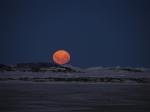 Moon Over Antarctica
Moon Over Antarctica
24.11.2005
Last week, the nearly Full Moon set along the northern horizion - as seen from Davis Station, Antarctica. The squashed orange pumpkin shape just silhouettes the peak of a distant iceberg in this stunning view.
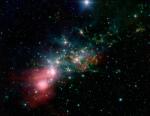 Dusty NGC 1333
Dusty NGC 1333
23.11.2005
Dusty NGC 1333 is seen as a reflection nebula in visible light images, sporting bluish hues characteristic of starlight reflected by dust. But at longer infrared wavelengths, the interstellar dust itself glows - shown in red in this false-color Spitzer Space Telescope image.
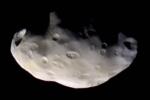 Pandora: A Shepherd Moon of Saturn
Pandora: A Shepherd Moon of Saturn
22.11.2005
What does Saturn's small moon Pandora look like? To help find out, the robot Cassini spacecraft now orbiting Saturn passed about 50,000 kilometers from the unusual moon in early September. The highest resolution image of Pandora ever taken was then captured and is shown above in representative colors.
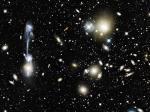 A Galactic Collision in Cluster Abell 1185
A Galactic Collision in Cluster Abell 1185
21.11.2005
What is a guitar doing in a cluster of galaxies? Colliding. Clusters of galaxies are sometimes packed so tight that the galaxies that compose them collide. A prominent example occurs on the left of the above image of the rich cluster of galaxies Abell 1185.
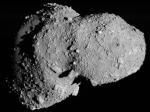 The Missing Craters of Asteroid Itokawa
The Missing Craters of Asteroid Itokawa
20.11.2005
Where are the craters on asteroid Itokawa? No one knows. The Japanese robot probe Hayabusa recently approached the Earth-crossing asteroid and is returning pictures showing a surface unlike any other Solar System body yet photographed -- a surface possibly devoid of craters.
 Rays from an Unexpected Aurora
Rays from an Unexpected Aurora
19.11.2005
This aurora was a bit of a surprise. For starters, on this Friday morning in August 2002, no intense auroral activity was expected at all. Possibly more surprising, however, the aurora appeared to show an usual structure of green rays from some locations.
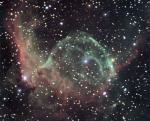 NGC 2359: Thor s Helmet
NGC 2359: Thor s Helmet
18.11.2005
(xxxedit and linkxxx) NGC 2359 is a striking emission nebula with an impressive popular name - Thor's Helmet. Sure, its suggestive winged appearance might lead some to refer to it as the "duck nebula", but if you were a nebula which name would you choose?
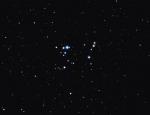 The 37 Cluster
The 37 Cluster
17.11.2005
For the mostly harmless denizens of planet Earth, the brighter stars of open cluster NGC 2169 seem to form a cosmic 37. (Did you expect 42?.) Of course, the improbable numerical asterism appears solely by chance and lies at an estimated distance of 3,600 light-years toward the constellation Orion.
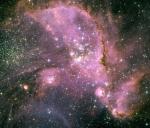 Young Stars of NGC 346
Young Stars of NGC 346
16.11.2005
Star cluster NGC 346 is embedded in the largest star forming region in the Small Magellanic Cloud, some 210,000 light-years distant. The massive stars of NGC 346 are short lived, but very energetic.
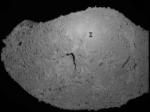 A Robots Shadow on Asteroid Itokawa
A Robots Shadow on Asteroid Itokawa
15.11.2005
What's that unusual looking spot on asteroid Itokawa? It's the shadow of the robot spacecraft Hayabusa that took the image. Japan's Hayabusa mission arrived at the asteroid in early September and has been imaging and maneuvering around the floating space mountain ever since. The above picture was taken earlier this month.
|
January February March April May June July August September October November December |
|||||||||||||||||||||||||||||||||||||||||||||||||